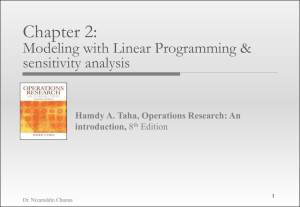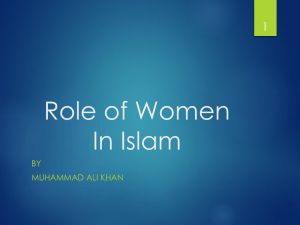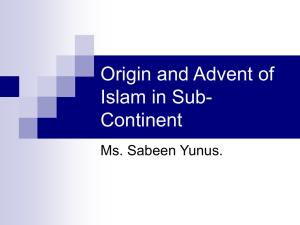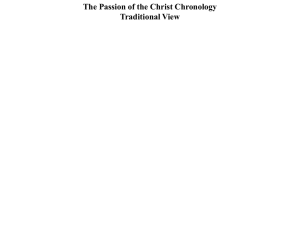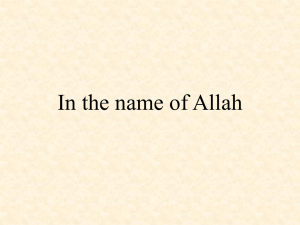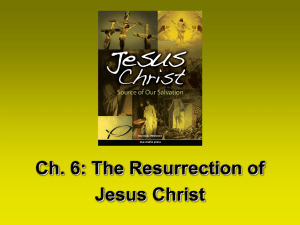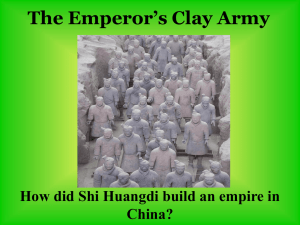Ethnographic study of Nizamuddin
advertisement
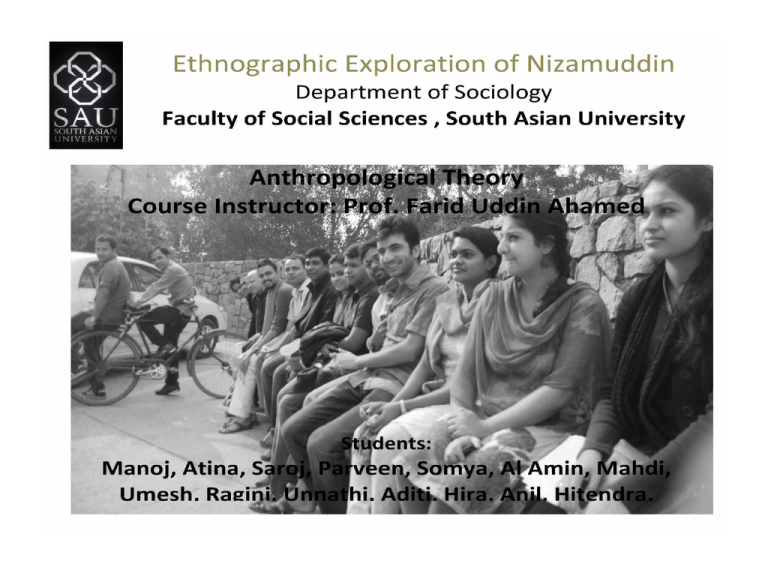
AN ANTHROPOLOGICAL EXPLORATION OF NIZAMUDDIN !!!!!! INTRODUCTION This research was conducted as a one day trip to explore the Nizamuddin locality initiated by our university, South Asian University, New Delhi, Department of Sociology, 1st semester. All the informations are based on a one day observation, interaction and overhearing of conversations. HISTORICAL BACKGROUND Hazarat Nizamuddin shrine is dedicated to one of the foremost Chishti sufi masters in South Asia of the 13th and 14th centuries, Nizamuddin Auliya (1325 A.D.) A settlement developed during his life time and was known as Ghayaspur but now is known as the Nizamuddin basti. The shrine was built by Muhammad Tuglaq and the original tomb has been renovated many times since 1562 when it was built. AMBIENCE OF THE MARKET [ ECONOMIC PERSPECTIVE] As one enters the area of Nizamuddin one can find an antiquated atmosphere: confusing allays; crowds of beggars and street vendors; a number of individual stalls selling caps, rosaries (tasbeeh), religious books, meswak (tree bark for cleaning teeth) , cheap eateries hawking kababs ,biryanis and many other delicacies. A shopkeeper selling kabab. A shopkeeper selling a traditional sweet called ‘anarsa’ A vendor selling ‘biryani’ in his three wheeler. A vendor selling ‘namazi topi’ which is wore during namaz by males. As the road narrows we can meet sellers who would affectionately pester the people to buy flowers, attar (perfume), chadaur, sweets to offer at the dargah. It was also amazing to see some women and children stall owner’s equally active and shouting and calling customers to buys the products from their stall. ‘Chadur’ on sale outside the dargah Roses on sale for the devotes visiting the dargah A women in her stall selling roses and chadur A child busy working A vendor below the age of 18 selling ‘meswak’ ‘The attar seller’ The economy here is totally oriented towards the fulfillment of the religious demand of the devotees and therefore the dominance of the product in this market is all religiously significant in some sense or the other. It is important to notice how items of religious sanctity have been commodified in the market. For eg- a pharmaceutical store is named as ‘AZIMUDDIN’ this word rhymes with the word Nizamuddin and quickly catches the attention of the customers. It is also portrayed in its advertisement that it sells ‘modern’, ‘unani’ and ‘ayurvedic’ medicine thus catering to all sections of people, those who believe in both modern and traditional cure process. The Cultural Treat of Nizamuddin. *two different religious orientation -Tablighi Jamaat vs Sufism The white mosque, called Masjid Banglewali, which towers over the surrounding buildings in the neighborhood of the famed Nizamuddin Dargah and overlooks the Urs Mahal, the erstwhile abode of the revered Sufi saint Hazrat Nizamuddin Auliya in New Delhi is the international headquarters of Tablighi Jamaat, roughly translated as the group for the propagation of Islam in its truest spirit. The address couldn’t have been more ironic. To be located in such a neighbourhood is ironic for the Tablighi Jamaat because the Jamaatis do not believe in Sufism and refuse to accept the divinity accorded to the sufi saints. Masjid Banglewali *The local people and their way of life Entering the busy life of the Nizamuddin area an outsider could easily understand that the people of this locality have dedicated their lives to the service of God in their own unique forms; every one somehow evokes the sense that God is present amongst us. It might either be the quawalli songs or the different articles for sale in the market or the people dressed in the proper Islamic attire. For eg- we found this little kid sitting quietly just outside his home, properly dressed and wearing the cap that is an important Islamic symbol We were surprised to find a house just outside the dargah that contained the tag that ‘Christ is the head of this house’ and we were totally mesmerized to find people from different religious community living peacefully even when there is a huge difference between the majority (Muslims) and other religious community. Moreover we can also find people from different strata living together in this locality. From poor to the rich people live here harmoniously. One will find both local stores and the high prized stores (eg- the perfume stores) in the market. In addition one could also find dilapidated houses all around the street but with air conditioners showing that the standard of living of the people here is not that bad as it looks from outside due to the decrepit infrastructure. The area around the tomb is also of cultural significance as it is regarded as sacred. Twice every year, the festival of 'Urs' is celebrated here to commemorate the death anniversaries of Hazrat Nizamu'd-Din Auliya and Amir Khusrau. A high priced attar shop ARCHITECTURE *CHAUSATH KHAMBA- Chausath Khamba monument was initially built as a hall in an innovative eclectic architectural style of the Mughal period. It was later converted into a tomb. It is a square structure constructed entirely of white marble. According to inscriptions, the structure houses the tomb of Mirza Aziz Koka (also named Kotaltash). The tomb of his father, Ataga Khan, the Prime Minister of Akbar, is also in the vicinity. CHAUSATH KHAMBA- *URS MAHAL - Located in front of the Chausath Khamba, URS Mahal is an assembly hall (pictured in the gallery) where Khawwali programmes are held on festival days and on the days during “Urs of sufi saint Nizamuddin Auliya ”. It is a protected monument (refurbished in 2003). URS MAHAL *Mirza Ghalib’s tomb- Mirza Ghalib's tomb is a small tomb of famous Urdu poet Mirza Ghalib (1797–1869), who was renowned in Urdu and Persian poetry during the Mughal Period . It is a protected monument. The tomb is a work of art located north of the enclosure of the Chausath Khamba. Mirza Ghalib’s tomb *the Ghalib Academy -Adjoining Ghalib's tomb, the Ghalib Academy has been established. The academy has a library of Urdu Literature. It also houses a museum that displays a sizable collection of rocks, paintings and works of Mirza Ghalib. The Ghalib Academy We also found lots of open and close mausoleums around this place. The story behind it, as many locals say, is that the followers of Hazrat Nizammudin wanted to remain close with him even after their deaths, and thus by burying themselves nearby Nizamuddin’s mausoleum they believed they would join him in the afterlife. These followers include, Jahanaara, daughter of Shahjahan, Amir Khusro, Mirza Ghalib, Hazrat Inayat Khan and many more. Conclusion We attended a Sufi music performance in the end which was very mesmerizing. It showed how Allah lies in our heart and could be worshipped and remembered through music which is not a very new concept and is also followed in other religion as well. Sufi music considers the human soul as the soul of a women waiting for her loved to be united with him and it also relates to Allah and the desire to unite with the Lord. The trip to Nizamuddin was very informative and interesting. This particular part of the city of Delhi is totally different and any outsider as soon as he/she enters the area could easily understand the difference. People here are day to night busy in all forms of activities that help them to engage with God. This place has its own aura and divinity and the areas close to the dargah is considered very sacred. The dargah welcomes people from all section and strata of life without any discrimination. People from all kinds of religion also come to pray here very often. The economic and the socio-cultural environment here is totally vibrant and has been adapted according to the needs of the devotes who visit this place in large number. Busy night life in Nizamuddin Hazrat Nizamuddin Thank you
